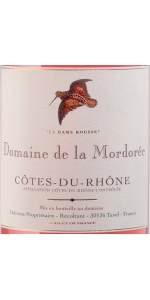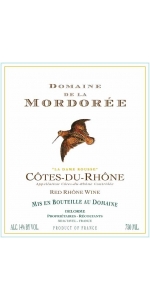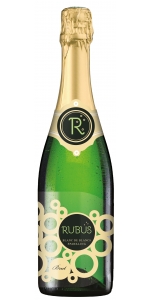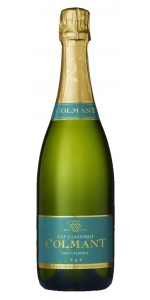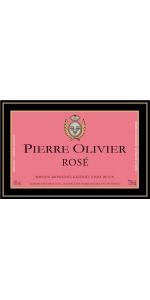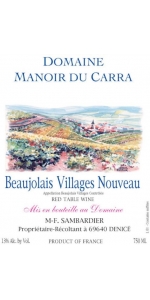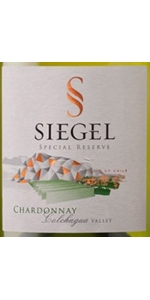Mordoree Cotes du Rhone Rose 2019
Mordoree Cotes du Rhone Dame Rousse Rose is made from 40% Grenache, 35% Syrah, 15% Cinsault, 5% Carignan, 5% Mourvèdre
Color : rosé, slightly orange (mordorée colour).
Aromas : crystallized oranges and cherries, slightly aniseed.
Palate : very rounded, fresh and long finish.
Ageing potential : 2 to 3 years
Surface : 14 Ha. Yield : 45 Hl./Ha. Vineyard age : 20 years Terroir : clay / chalk,clay / limestone and sandy with pebble stones. Harvest : by hand. Vinification : vat bleeding, temperature control. Estate bottled.
Food pairing: cold meats and delicatessen, fowl, white meats, grilled lamb with Provence herbs, fish soup, fried fish, pastas, pizzas and all Asian dishes.
Review:
This estate makes brilliant rosé, and the 2021 Côtes Du Rhône Rosé might be the best I've tasted from the vintage. Ripe raspberries, white flowers, and beautiful minerality define the aromatics, and it's medium-bodied on the palate, with a fresh, elegant, almost crystalline-like texture that keeps you coming back to the glass. Seemingly in between a Provencal rosé and a Tavel, it's going to be incredibly versatile on the dinner table. Don't miss it.
-Jeb Dunnuck 92 Points
Mordoree Cotes du Rhone Dame Rousse Rose is made from 40% Grenache, 35% Syrah, 15% Cinsault, 5% Carignan, 5% Mourvèdre
Color : rosé, slightly orange (mordorée colour).
Aromas : crystallized oranges and cherries, slightly aniseed.
Palate : very rounded, fresh and long finish.
Ageing potential : 2 to 3 years
Surface : 14 Ha. Yield : 45 Hl./Ha. Vineyard age : 20 years Terroir : clay / chalk,clay / limestone and sandy with pebble stones. Harvest : by hand. Vinification : vat bleeding, temperature control. Estate bottled.
Food pairing: cold meats and delicatessen, fowl, white meats, grilled lamb with Provence herbs, fish soup, fried fish, pastas, pizzas and all Asian dishes.
Review:
"This rosé appears so pretty in the glass with its watermelon hue and presents a refreshing summery nose. Find notes of watermelon slices and yellow peaches sprinkled with sea salt. Think of pairings similar to prosciutto-wrapped melon. This is a solid rosé to enjoy all summer long."
- Wine Enthusiast (May 2023), 91 pts
Mordoree Cotes du Rhone Dame Rousse Rose is made from 40% Grenache, 35% Syrah, 15% Cinsault, 5% Carignan, 5% Mourvèdre
Color : rosé, slightly orange (mordorée colour).
Aromas : crystallized oranges and cherries, slightly aniseed.
Palate : very rounded, fresh and long finish.
Ageing potential : 2 to 3 years
Surface : 14 Ha. Yield : 45 Hl./Ha. Vineyard age : 20 years Terroir : clay / chalk,clay / limestone and sandy with pebble stones. Harvest : by hand. Vinification : vat bleeding, temperature control. Estate bottled.
Food pairing: cold meats and delicatessen, fowl, white meats, grilled lamb with Provence herbs, fish soup, fried fish, pastas, pizzas and all Asian dishes.
Review:
"Based on 40% Grenache, 30% Syrah, 15% Cinsault, and the rest Carignan and Mourvèdre, awesome notes of framboise, wild strawberries, exotic spices, and a kiss of pressed flowers all emerge from the 2023 Côtes du Rhône Rosé, a beautifully balanced, medium-bodied rosé that has ample richness and depth. This stunning rosé is up with the best of them."
- Jeb Dunnuck (Importer Highlight: Fran Kysela ; July 2024), 92 pts
Mordoree Cotes du Rhone Rouge La Dame Rousse is made from 40% Grenache, 35 % Syrah, 15% Cinsault, 5% Carignan, 5% Counoise.
100 % destemming, 15 day maceration with a maximum of 30° C temperature
Deep red color. Blackcurrant and violet aromas. Melted and fine tannins, good finish.
Food pairing: cold meats and delicatessen, grilled meats, semi-mature cheeses.
Mordoree Cotes du Rhone Rouge La Dame Rousse is made from 40% Grenache, 35 % Syrah, 15% Cinsault, 5% Carignan, 5% Counoise.
100 % destemming, 15 day maceration with a maximum of 30° C temperature
Deep red color. Blackcurrant and violet aromas. Melted and fine tannins, good finish.
Food pairing: cold meats and delicatessen, grilled meats, semi-mature cheeses.
Review:
"A very satisfying red Cotes-du-Rhone with plenty of black-cherry fruit and rather fine-grained tannins filling out the expansive palate. Lively acidity lifts the finish nicely. A blend of grenache and syrah with a touch of cinsault. From biodynamically grown grapes with Demeter certification. Drink now."
- James Suckling (February 2022), 90 pts
Mordoree Cotes du Rhone Rouge La Dame Rousse is made from 40% Grenache, 35 % Syrah, 15% Cinsault, 5% Carignan, 5% Counoise.
100 % destemming, 15 day maceration with a maximum of 30° C temperature
Deep red color. Blackcurrant and violet aromas. Melted and fine tannins, good finish.
Food pairing: cold meats and delicatessen, grilled meats, semi-mature cheeses.
Mordoree Cotes du Rhone Dame Rousse Rose is made from 4 0% Grenache, 35% Syrah, 15% Cinsault, 5% Carignan, 5% Mourvèdre
Color : rosé, slightly orange (mordorée colour).
Aromas : crystallized oranges and cherries, slightly aniseed.
Palate : very rounded, fresh and long finish.
Ageing potential : 2 to 3 years
Surface : 14 Ha. Yield : 45 Hl./Ha. Vineyard age : 20 years Terroir : clay / chalk,clay / limestone and sandy with pebble stones. Harvest : by hand. Vinification : vat bleeding, temperature control. Estate bottled.
Food pairing: cold meats and delicatessen, fowl, white meats, grilled lamb with Provence herbs, fish soup, fried fish, pastas, pizzas and all Asian dishes.
Review:
"The 2019 Cotes Du Rhone La Dame Rousse Rose offers another level of elegance and purity as well as complexity. Giving up notions of ripe strawberries, cherry blossoms, white flowers, and a kiss of minerality, it’s a beautifully textured, medium to full-bodied, incredibly balanced effort that actually has a touch more richness than the Tavel, although both are rich, textured rosés geared for the table. As with the Tavel, drink this beauty any time over the coming year or so."
- Jeb Dunnuck (March 2020), 92 pts
- Wine Enthusiast (Semptember 2020), 92 pts, Editors' Choice
The Mordoree Estate
This is arguably the top estate in our Portfolio. Domaine de la Mordoree (woodcock), located in the town of Tavel, in the Southern Rhone Valley, is the most consistent producer of top quality wine in my entire selection. In 1986, the brothers Christophe and Fabrice Delorme decided to dedicate themselves to their passion for wine. They started their own estate with the objective to produce the best wines in each appellation while preserving the environment
The Mordoree Vineyard
The vineyard consists of 55 hectares (135 acres), on 38 different parcels, which provide with a rich, wide range of soils and climates. The soil is a mix of clay, chalk and sand with pebble stones. The improvements at the Domaine have been incredible: new pneumatic presses, new stainless steel vats, new destemmer, new vinification and aging plant, and aging in oak barrels for the top wines. All the grapes are raised by culture raisonnée which is very close to organic viticulture (intervention in the vineyard only when necessary). The yield is reduced in the vineyard by ébourgeonnage (de budding in spring) and vendanges vertes in summer (green harvesting). Oak aging for the top wines in special barrels like “jupille” for 10 months. No expense is spared at this Domaine to achieve quality.
Rubus Brut Blanc de Blanc NV is made from 1/3 Ugni Blanc, 1/3 Airen, 1/3 Muscat .
The Rubus Project was created by Fran Kysela as a way to source & sell incredible wines at value prices. All wines in this international project are hand-selected by Fran Kysela. Rubus wines are fruit driven, true-to-type values that over deliver - a true representation of quality for the consumer at an excellent price.
Elegant pale yellow color with fine bubbles. Floral and fruity on the nose, with aromas of fresh butter and cake. On the palate, the wine is crisp and harmonious - a delightful sparkling wine.
Machine harvest. The base wine is fermented at a low temperature. The second fermentation takes place at 14°C for 2 weeks, followed by dosing.
IMPORTER SALE!
Blend: Colmant Brut Reserve NV is a blend of Pinot Noir 52%, Chardonnay 48% (Franschhoek, Robertson, Elgin, Somerset-West and Stellenbosch). 10% of the blend is made of reserve wine from the previous vintage and 12% of the base wine is barrel fermented.
Ageing: 28 months minimum on the lees at steady 13°C temperature.
Tasting: A subtle pale gold color with a very clean and elegant nose. The aroma has a gentle spicy toastiness with a lemon / yeasty perfume followed by more mature fruit. Plenty of freshness on the palate, with a good acidity which perfectly balances the yeasty depth, bready flavors and ample structure. Long smooth finish. Will develop nicely over the years.
Drinking tips: Divine as an aperitif and loyal as a party buddy, it also goes perfectly with oysters, sushis or any delicate seafood.
Reviews:
"The Brut Reserve (disgorged April 2018) was 10% fermented in French oak barrel and includes 20% reserve vintages. It spent 30 months on the lees. The well-defined, focused nose features bright citrus lemon and hints of baked bread. The palate is well balanced with a taut, crisp, citric entry. This is vivacious, very pretty and graced with lovely apricot hints on the finish. A superb MCC from Colmant. - Neal Martin"
- Vinous (August 28th 2018), 91 pts
"Fresh with leesy notes, a fine mousse and delicate palate of minerals and green citrus zest, this is a first class New World sparkler. It’s rich enough to enjoy on its own or with white meats. It’s a 50/50 blend of Pinot Noir and Chardonnay aged on the lees for 30 months and 25% reserve wines from earlier vintages."
-International Wine Review, 91 pts
"Disgorged February 2011, the Non-vintage Brut Reserve is a blend of 52% Pinot Noir and 48% Chardonnay based on the 2008 vintages blended with reserve wines from 2007 and 2006 (25% of the blend), aged for 30 months on the lees. It has a very fine pettillance in the glass. The nose is very well defined with crushed stone, oyster shell and the subtle perfume of fine lees coming through with aeration. The palate is very crisp and lively on the entry with vibrant acidity, a citrus thread from start to finish, and though it is not a powerful Cap Classique, it is wonderfully poised with great persistence on the fresh lime and Granny Smith-tinged finish.
There are many alternatives to Champagne, and South Africa is no exception with some fine “Method Cap Classique.” Jean-Philippe Colmant hired winemaker Nicolas Follet to create a small range of impressive sparkling wines; they eschew malolactic fermentation and practice extended lees aging."
- eRobertParker.com , 92 pts
Our Hunt for Colmant:
It was day 6 in South Africa and we find ourselves outside of beautiful Cape Town, in the country near the Riebeek Kasteel area in Swartland. Let's talk a little about my accommodations before I tell you about this amazing bubbly. We arrive at the one and only hotel in Riebeek to find out that there were not enough rooms open for all.
We reached out to our contact at Riebeek cellars, who we will refer to as "Point Break" from now on. For those of you that have not seen the movie Point Break, this guy looked and sounded like a blonde Keanu Reeves with a Dutch accent. Anyway, Point Break tells me that they have secured a small bed and breakfast that we could use for the overflow. Sounded nice...so I opted for it.
Upon arrival, the home was beautiful on the outside with a catchy French name, "Shades of Provence". After Point Break fiddled with the skeleton key and lock for a good 35 minutes in the rain, we finally get to see the inside of our new home. The door opened straight into the kitchen where the first thing I noticed was the mouse sh*t all over the place. It was winter there and the mice were trying to stay warm, I'm sure. Little did they know this damn place had no heat.
Besides myself and my fiancee Sylvia, there were 3 other people and a total of four rooms. At this point I knew I better drag both our suitcases up those steps and get to the best room before everyone else. At stroke-causing speed, I skipped up the steps nearly knocking Point Break on his back and went through the rooms. I settled for a nice corner room with the least amount of dirt on the concrete floor and with only one or two spider webs on the wrought iron bed post.
For dinner that night, we returned to the hotel restaurant to join the rest of our group. The 5 of us forced to stay in the bed and breakfast were in a far worse mood than everyone around us. Arriving late, we sat at the end of the dinning table and hoarded as much wine as possible to try and drink ourselves to a point where we could sleep in that disgrace of a French country side home that Point Break secured for us.
That night, I slept with the lights on, all my clothes on, and on top of the sheets hoping to avoid spider bites. I awoke that morning to Sylvia standing over me holding what looked like a hot water knob off of the shower. "It wasn't even attached.", she said. Sylvia proceeds to take a "whore-bath" in the sink using her own packed sock as a wash cloth. It was the only thing she deemed clean. To top it off, in a brief moment of happiness she finds a hair dryer in a cabinet. She pulled it out in triumph only to realize that there was a used condom stuck to the side of it. Obviously, this is her last trip to South Africa.
Pierre Olivier Sparkling Rose NV is a value sparkling rosé, made with Tempranillo grapes from around the French/Spanish border (next to the Pyrenees). This is a new Kysela Project.
This wine is aromatized with a very little amount of Raspberry flavor, giving a nice mouthfeel, with an extra aromatic boost.
The bubbles are obtained using the Charmat method, named after Eugene Charmat, where the second fermentation takes places in a large, closed pressurized tank. It is different from the Methode Champanoise as the secondary fermentation doesn't take place in the bottle.
"Pale pink salmon. Just a touch off-dry, this is a very pleasant sparkler that reveals aromas of spicy red apple with a hint of cinnamon that carry through to the palate. Well made and exceedingly pleasant to drink."
- International Wine Review (Annual Rosé Report / April 2013), 89 pts
Bright golden color, balanced acidity and sweetness. Taste of cinnamon, vanilla, liquorice and clay. Pleasant finish with bitter herbs.
In 1904 Cherubino Valsangiacomo produced the first vermouth bottle, afther 100 years, the fifth generation of the Valsangiacomo familly STILL making it with the ancestral formula devised by Benedetto Valsangiacomo.
White Vermouth, flavored fortified white wine base, together with aromatic mediterranean herbs such as fennel, chamomille and tyme, sweeted with sugar, and grape must caramel.
Ideal as an aperitif, on the rocks with an lemon slice. Also very good with cured and pickled products.
Redolent of strawberries and roses, fragrant and medium bodied. Refreshing, tart finish.
Average age of the vines: 30 years old (between 20 and 60 years old). Skin contact maceration: between 2 and 5 days depending on the parcels.
Beaujolais-Nouveau has been very popular with almost every Thanksgiving dish - from turkey to ham, green beans to mashed potatoes, and gravy to cranberry sauce.
Siegel Special Reserve Chardonnay is made from 100 percent Chardonnay.
This Chardonnay has a pale yellow color. On the nose is is complex with citrus and tropical fruit aromas balanced with notes from the oak aging. On the palate it has good acidity with a long finish.
VINIFICATION: Alcoholic fermentation occurs at 16-17 degrees C. When the alcoholic finishes part of the wine is kept on a pump-over program.
FINNING AND FILTRATION: Once the wine has been blended it is clarified and then undergoes cold stablisation and is later filtered through clay.
AGING: Aged in French oak barrels for 6 months.
Pairs well with fish like Tilapia, salmon and white meats.
- back
Charles Smith Sixto Uncovered Chardonnay is made from 100 percent Chardonnay.
Not from here, this wine is otherworldly. Apricot, stone, pippin apple, sea breeze, and wildflowers mingle to create this compelling beauty. Sit down and take your time with this wine, to savor the incredible structure, with a long and lingering presence of toasted almonds, apple blossom, and flint. A wonderful journey!.
Review:
What a pretty nose. Lemon peel, fresh white flowers, lavender, crushed sage and wet stone. Medium-to full-bodied with carrying acidity. Extremely articulate and graceful on the palate with bright citrus and a dried-floral note. Impressive depth and length. Salty and tangy on the finish with vibrancy. Drink or hold.
-James Suckling 96 Points
Thorn Clarke Shotfire Shiraz is made from 100% Shiraz.
Striking deep red-purple in color. A rich, voluptuous wine with aromas of blackcurrant and mulberries accompanied by notes of smokey oak and hints of cloves. The palate is filled with dark fruits and chocolate backed up by taut tannins and lingering oak.
Story:
When the Clarke forebearers discovered gold in 1870 at the Lady Alice mine in the Barossa goldfields, so began a family dynasty intrigued by geology. A fine legacy that is reflected today in the terroir of our vineyards. The Shotfire range immortalizes the Shotfirer's hazardous job of setting and lighting the charges in the mines.
Fran shares his story on how he discovered Thorn-Clarke:
"It was October 2001 and I was searching for and sourcing for Australian wines, as it was clear that Australia was going to become the "next big thing." After tasting about 100 assorted wines, I decided I liked the style of Barossa, Shiraz best - chocolate, cherries, mint and eucalyptus - so I started focusing on Barossa growers (years later, Barossa Shiraz would develop its reputation as the Icon Shiraz for Australia).
Late on a Thursday afternoon, the carrier delivered a beat-up box of 12 bottles from Australia, 10 of which were leaking. The box was from a guy named Steve Machin, who had just left Hardy's and was beginning work with the Clarke family on setting up a possible new brand. The samples were sticky and messy, but I popped the corks anyway ..... and I was glad that I did. The wine inside tasted like Christmas - mint, eucalyptus, camphor, and evergreen aromas. Great acidity, color, flavor and length of finish - very tasty. These samples were so good and so exciting, especially compared to what I had tasted prior, that I immediately called the number on the card. I didn't realize that it was a Perth number (Western Australia) and it was actually 3:00 in the morning. It turned out I was calling the residence of David and Cheryl Clarke, where a sleepy Cheryl answered the phone. I told her, you don't know who I am, but we are going to be doing business together very soon, and lots of it! After a few months of talking, faxing (yes, faxing) and sorting out the details, I began importing their wines.
That super-star wine from the busted box of samples is the wine we know today as Shotfire Shiraz. It was originally called Stone Jar, but fortunately we came up with a better name. Many years and vintages later, I'm still glad to be importing Shotfire Shiraz and other Thorn-Clarke selections .... and I'm still glad that Cheryl Clarke woke up for that phone call."



